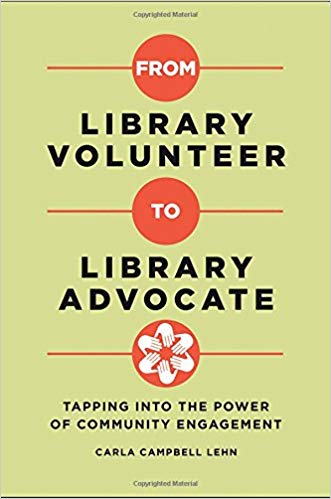
Recruiting, retaining, and leading volunteers can be a challenge.
Libraries in California have developed an engagement strategy that provides a good model that can benefit others.
The following article is based a book review I wrote for The Voice, which is published by United for Libraries, a division of the American Library Association.
Carla Campbell Lehn’s book From Library Volunteer to Library Advocate: Tapping into the Power of Community Engagement, chronicles the California Library Volunteer Engagement Program.
Today’s library is much different from the one I frequented growing up in my hometown. The fact that their world is undergoing dramatic change is no surprise to librarians.
A shift in user behavior and the effects of declining funding have significantly impacted libraries. The result is that the evolution of space previously devoted to books is being re-purposed for serving a variety of public use programming. And although services are increasing, staffing reductions present an ongoing struggle.
Lehn’s book creates a platform that encourages librarians to incorporate a carefully structured volunteer program as a primary strategy for adapting to meet these changes.
She delivers a well-defined case for rethinking how volunteers are engaged and provides guidance for implementing a successful volunteer program. Essential to her message is the importance of understanding that just as libraries are changing, so are volunteers.
The book is written as a follow-up to California State Library’s “Get Involved” initiative for training libraries in new approaches to volunteer engagement. California’s success has influenced other states to adopt similar strategies.
Making this a valuable go-to resource is the insightful advice Lehn offers; for example, an explanation of why the best practices of previous volunteer programs have become ineffective as new generations are demonstrating a change in preferences for volunteer involvement.
Today’s volunteers want their donated time to have impact. They don’t want to be relegated to tasks they feel are busy work, such as returning books to shelves.
Lehn counsels implementing a more modern day program that requires working with structured planning, including elements such as clarity of purpose and goals with measurable outcomes. She mentions that staff buy-in, coordination oversight, evaluation, and reporting results achieved by the program are critical for sustained success.
Another example of the priority practices she recommends is to go beyond the typical application process with prospective volunteers: utilize personal interviews to determine their true motivation and qualifications, and identify personality traits that will best match up talents to tasks. This will help establish whether or not an individual is a good fit.
Lehn encourages converting volunteers into community engagement advocates who help create support for libraries. In addition following her carefully developed directions will build a foundation for long-term advocacy success.
Carla Campbell Lehn’s encouragement of taking a new approach to volunteer engagement is on point. Readers will benefit from the practical strategies she offers, ones that are based on her considerable experience in working with volunteers and libraries.
What makes this book a valuable resource is that it (1) is based on proven techniques, (2) states why the author’s recommended approach should be implemented, and (3) provides necessary how-to actions that are supported by detailed templates, step-by-step descriptions, and helpful resource references.
I especially appreciated that Lehn addresses myths often associated with volunteers, reinforcement for working with structure, and emphasis on the differences between management and volunteer engagement. Heeding her advice and utilizing the resources she provides will help avoid many common mistakes related to volunteer programs.
From my own work as a professional speaker and consultant to organizations that utilize volunteers, I recognize the value of Lehn’s writing and will recommend it as a resource. While it may be focused on libraries, it will also benefit any organization that has a volunteer program, or that wants to implement one.
This is a well-written resource that provides an excellent guide for enhancing volunteer services and growing a library’s base of advocates and supporters. Volunteer program coordinators at any experience level and in any size library can benefit by following its recommendations for taking action.
Congratulations to my California library friends on your success implementing this volunteer program!
Have you had volunteer engagement success? Sharing what has worked for your organization would be appreciated! Comment below.
Previous Article
Next Article